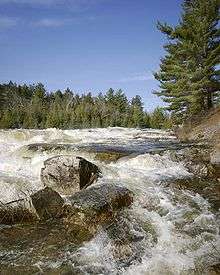Freshet
The term freshet is most commonly used to describe a spring thaw resulting from snow and ice melt in rivers located in the northern latitudes of North America. A spring freshet can sometimes last several weeks on large river systems, resulting in significant inundation of flood plains as the snowpack melts in the river's catchment area. Freshets occur with generally diminishing strength and duration depending upon the snowpacks having large accumulations and then the local average rates of warming temperatures; late spring melts allowing faster flooding from the relatively longer days and higher solar angle against more southerly latitudes and elevations reaching average melting temperatures sooner where earlier and generally lesser seasonal snow piles melt more gradually spread over a longer melt period. Serious flooding from southern freshets are more often related to rain storms of large tropical weather systems rolling in from the South Atlantic or Gulf of Mexico, to add their powerful heating capacity to lesser snow packs. Tropically induced rainfall influenced quick melts can also affect snow cover to latitudes as far north as southern Canada, so long as the generally colder air mass is not blocking northward movement of low pressure systems.
In the eastern part of the continent, annual freshets occur from the Canadian Taiga ranging along both sides of the Great Lakes then down through the heavily forested Appalachian mountain chain and St. Lawrence valley from Northern Maine into barrier ranges in North Carolina and Tennessee.
In the western part of the continent, freshets occur throughout the generally much higher elevations of the various west coast mountain ranges that extend southward down from Alaska even into the northern parts of Arizona and New Mexico.
- The term can also refer to the following:
- A flood resulting from heavy rain or a spring thaw.[1] Whereas heavy rain often causes a flash flood, a spring thaw event is generally a more incremental process, depending upon local climate and topography.
- A stream, river or flood of fresh water which empties into the ocean, usually flowing through an estuary.[2]
- A small stream of fresh water, irrespective of its outflow.[2][3]
- A pool of fresh water, according to Samuel Johnson[4] and followed in Thomas Sheridan's dictionary, but this might have been a misinterpretation on Johnson's part, and it is at best not a common usage.[5][6]
References
- ↑ Gieck, Jack (1988). A Photo Album of Ohio's Canal Era, 1825–1913. Kent State University Press. pp. xvii.
- 1 2 Brown, Lesley (1993). The New shorter Oxford English dictionary on historical principles. Oxford [Eng.]: Clarendon. ISBN 0-19-861271-0.
- ↑ Bonnier Corporation (January–June 1907). Popular Science. Bonnier Corporation. pp. 68–. ISSN 0161-7370.
- ↑ Samuel Johnson (1773). A Dictionnary of the English Language. pp. 196–.
- ↑ Thomas Sheridan (1789). A Complete Dictionary of the English Language, Both with Regard to Sound and Meaning ...: To which is Prefixed a Prosodial Grammar. C. Dilly. pp. 286–.
- ↑ Timothy Dwight (1822). New-England and New-York. pp. 286–.
External links

